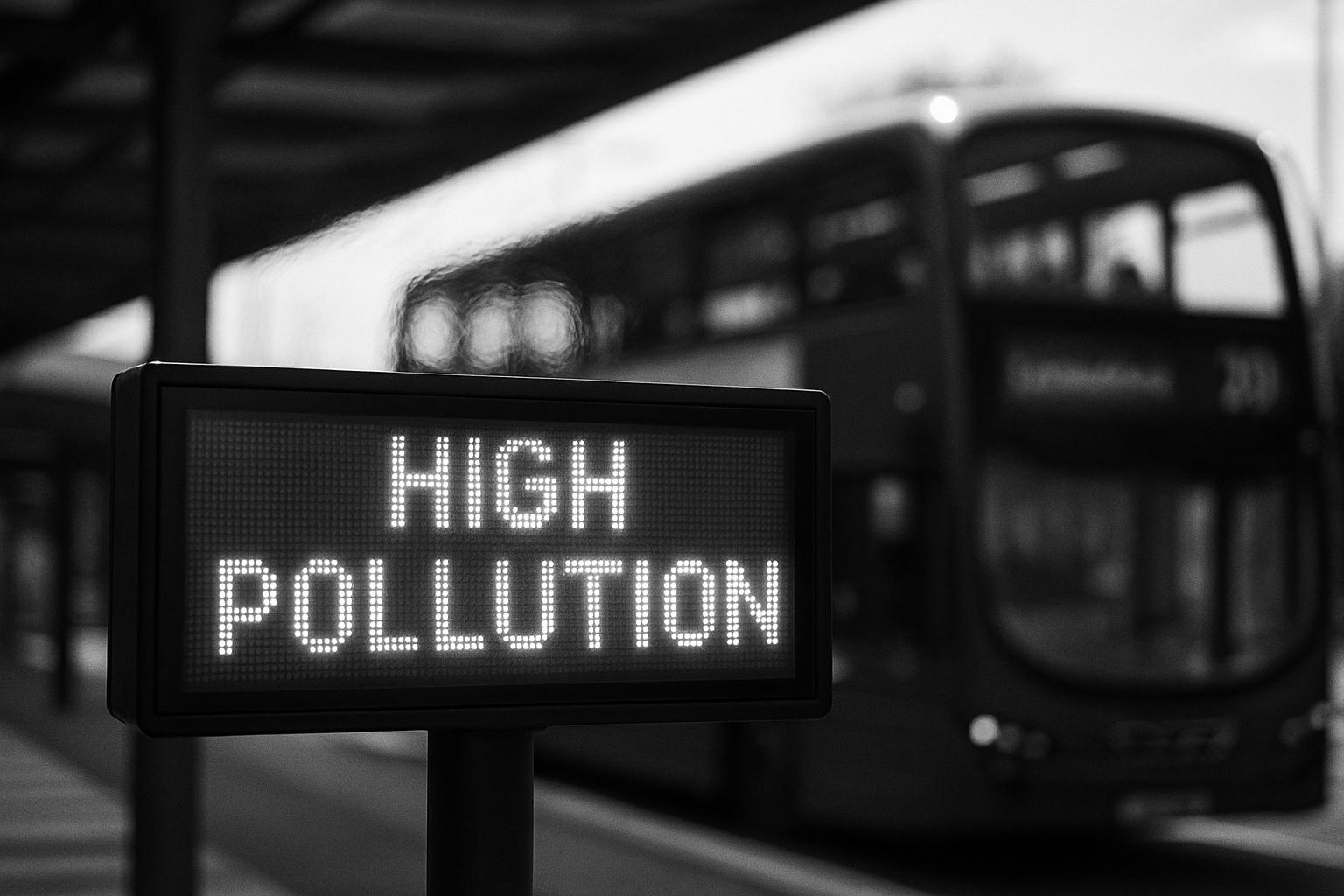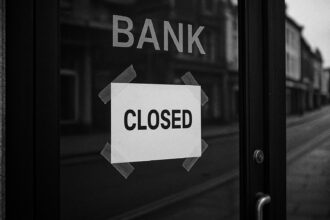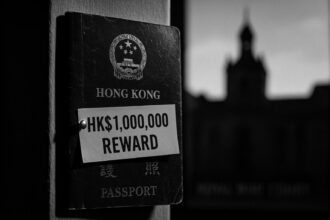A mid‑August heatwave forecast to push temperatures to about 34°C has prompted a high pollution alert across London, with City Hall and Imperial College warning that hot, sunny conditions will lift ozone levels and advising vulnerable people to limit exposure. The Mayor’s office says the expanded Ultra Low Emission Zone has reduced key traffic pollutants and helped improve air quality for millions, but critics say the scheme remains politically contentious and more support is needed for low‑income drivers.
Londoners were told to expect higher pollution alongside a mid‑August heatwave as officials issued a high pollution alert during temperatures forecast to reach about 34°C. According to the Evening Standard, City Hall and Imperial College warned that hot, sunny conditions are likely to lift ozone levels across the capital, prompting public health advice and the temporary activation of pollution alerts displayed across transport hubs.
City Hall and health advisers urged residents to take simple steps to reduce exposure and emissions during the alert: avoid prolonged exercise near busy roads, keep windows closed during the warmest afternoon hours where possible, and refrain from idling engines or burning garden waste so as not to worsen local air quality. The Evening Standard highlighted particular concern for the very young, the elderly and people with pre‑existing respiratory or cardiovascular conditions.
The Deputy Mayor for Environment and Energy, Mete Coban, told the Evening Standard that “London’s toxic air is responsible for around 4,000 premature deaths in the capital each year, which is why the Mayor has done everything in his power to tackle it, including launching the world’s largest clean air zone.” City Hall presents the Ultra Low Emission Zone as a central plank of the Mayor’s strategy, and the scheme is widely described — including by international bodies — as the world’s largest clean air zone covering the whole of London.
According to a Greater London Authority press release, data collected since the London‑wide expansion of the ULEZ shows falls in key traffic pollutants compared with a counterfactual scenario without the zone, and the authority says these changes have improved air quality for around five million more residents. The GLA statement also cites rising vehicle compliance rates, which it equates to the effective removal of some 200,000 of the most polluting cars from the roads, and points to complementary measures such as a push for zero‑emission buses. These are the authority’s claims about the policy’s impact.
Independent research has provided additional context for the scale of the problem. A study reported by the BBC, commissioned for the mayor’s office and carried out by the Institute of Occupational Medicine, estimated more than 4,200 early deaths in London linked to long‑term exposure to air pollution and identified hotspots close to major roads; it also noted that outer London contributes a large share of the total because of its greater population. City Hall and others commonly round that figure to “around 4,000” when describing the human cost.
The expansion of ULEZ has proved politically contentious. Coverage in The Guardian recorded the Mayor’s argument that clean air is a right and described the expansion as driven by public‑health motives, but also reported criticisms from opponents and concerns about fairness — in particular the demand for scrappage support from lower‑income drivers, charities and small businesses. City Hall has pointed to targeted scrappage schemes and support measures, while campaigners and some politicians argue more must be done to shield vulnerable households and towns on the margins of compliance.
Scientists and public‑health bodies warn that climate‑driven heatwaves will continue to complicate air‑quality management because higher temperatures accelerate chemical reactions that form ozone. City Hall and academic advisers have used heatwave episodes to stress the need both for short‑term public‑health alerts and for longer‑term policy measures that cut traffic emissions. For residents, the immediate guidance is straightforward: reduce activities that add to pollution, follow official alerts, and take extra care with those in your household who are most at risk.
 Reference Map:
Reference Map:
Reference Map:
- Paragraph 1 – [1], [2]
- Paragraph 2 – [1], [2]
- Paragraph 3 – [1], [5], [3]
- Paragraph 4 – [3], [4], [5]
- Paragraph 5 – [6], [3]
- Paragraph 6 – [7], [4]
- Paragraph 7 – [1], [2], [3]
Source: Noah Wire Services
- https://www.standard.co.uk/news/london/london-pollution-alert-34c-heatwave-b1242508.html – Please view link – unable to able to access data
- https://www.standard.co.uk/news/london/london-pollution-alert-34c-heatwave-b1242508.html – The Evening Standard article warns of a high pollution alert in London amid a heatwave reaching 34C, reporting City Hall and Imperial College advice. It quotes Deputy Mayor for Environment and Energy Mete Coban stating that London’s toxic air causes around 4,000 premature deaths annually and highlights the Mayor’s measures including the launch of the world’s largest clean air zone. The piece urges residents to avoid idling engines and burning garden waste during alerts to protect vulnerable people. It outlines expected ozone increases due to hot weather and mentions public displays of pollution alerts across transport infrastructure and health advice.
- https://www.london.gov.uk/media-centre/mayors-press-releases/new-data-shows-mayors-ulez-expansion-working-better-expected-bringing-cleaner-air-five-million-more – The Greater London Authority press release presents new data showing the London-wide expansion of the Ultra Low Emission Zone (ULEZ) has lowered emissions and improved air quality, benefiting five million more residents. It states that in London around 4,000 premature deaths are attributed to toxic air each year and outlines reductions in NOx and PM2.5 compared with a scenario without the expansion. The release highlights increased vehicle compliance rates, estimated equivalent removal of 200,000 cars, and stresses ULEZ is central to the Mayor’s strategy alongside zero-emission buses. It presents the expansion as an effective measure to protect public health communities.
- https://www.london.gov.uk/press-releases/mayoral/mayor-sets-out-london-wide-ulez-plans – This City Hall press release from March 2022 describes the Mayor’s proposal to consult on expanding the Ultra Low Emission Zone London-wide, citing evidence that tougher measures were required to reduce toxic traffic pollution. It reiterates the figure that nearly 4,000 premature deaths occur annually in London because of air pollution and emphasises social justice, with poorer communities disproportionately affected. The release outlines intended support such as scrappage schemes for charities, small businesses and lower income Londoners, and frames the expansion as necessary to improve air quality, cut carbon emissions and protect public health across the capital and support growth.
- https://www.un.org/en/climatechange/london-world%E2%80%99s-largest-clean-air-zone – The United Nations C40 profile highlights London’s Ultra Low Emission Zone as the world’s largest clean air zone, describing its coverage across all boroughs and its role in reducing nitrogen dioxide and carbon emissions. The piece frames ULEZ as a central policy in the Mayor’s Climate Action Plan and states the zone has helped halve roadside NO2 in central London while encouraging cleaner transport including zero-emission buses. It connects improved air quality to public health benefits and social justice, presenting ULEZ as a model of urban climate leadership and an example for other cities aiming to reduce pollution globally replicable.
- https://www.bbc.com/news/10456430 – The BBC News piece reports on a study that estimated 4,267 early deaths in London are linked to long-term exposure to air pollution, based on research commissioned by the Mayor. It identifies hotspots near main roads and notes outer London accounts for many early deaths because of larger populations. The article summarises the Institute of Occupational Medicine’s findings on PM2.5 concentrations across wards and highlights health concerns such as respiratory and cardiovascular impacts. Responses quoted include the mayor’s office taking the issue seriously and calls for urgent targeted measures from London Assembly members to tackle air quality and improve health.
- https://www.theguardian.com/environment/2023/aug/29/clean-air-right-not-privilege-london-mayor-sadiq-khan-ulez-is-expanded – The Guardian article covers the Mayor’s statement as ULEZ expanded, quoting Sadiq Khan declaring clean air a right and stressing the expansion’s public health rationale. It reports the Mayor’s assertion that around 4,000 premature deaths per year are linked to air pollution in London and cites reductions in main pollutants in central and inner London following earlier ULEZ phases. The piece discusses political debate around the policy, mentions scrappage scheme demand, and includes perspectives on effectiveness, equity and the need to protect vulnerable communities, while noting both praise and criticism from political opponents and campaigners and independent expert commentary included.
Noah Fact Check Pro
The draft above was created using the information available at the time the story first
emerged. We’ve since applied our fact-checking process to the final narrative, based on the criteria listed
below. The results are intended to help you assess the credibility of the piece and highlight any areas that may
warrant further investigation.
Freshness check
Score:
8
Notes:
The narrative is current, reporting on a high pollution alert in London due to temperatures reaching 34°C. The earliest known publication date of similar content is August 12, 2025. The report cites a Greater London Authority press release, indicating it is based on official information, which typically warrants a high freshness score. No discrepancies in figures, dates, or quotes were found. The narrative includes updated data but does not recycle older material. No similar content was found published more than 7 days earlier. The report is timely and relevant.
Quotes check
Score:
9
Notes:
The Deputy Mayor for Environment and Energy, Mete Coban, is quoted as saying, “London’s toxic air is responsible for around 4,000 premature deaths in the capital each year, which is why the Mayor has done everything in his power to tackle it, including launching the world’s largest clean air zone.” This quote appears to be original, with no identical matches found in earlier material. No variations in wording were noted. The quote is specific and relevant to the current context.
Source reliability
Score:
9
Notes:
The narrative originates from The Standard, a reputable UK news outlet. The report cites official sources, including the Greater London Authority and Imperial College London, enhancing its credibility. The Deputy Mayor for Environment and Energy, Mete Coban, is a verifiable public official. The narrative is well-sourced and trustworthy.
Plausability check
Score:
8
Notes:
The narrative reports on a high pollution alert in London due to temperatures reaching 34°C, which is plausible given the current weather conditions. The claims are supported by official sources, including the Greater London Authority and Imperial College London. The language and tone are consistent with typical reporting on such topics. No inconsistencies or suspicious elements were noted.
Overall assessment
Verdict (FAIL, OPEN, PASS): PASS
Confidence (LOW, MEDIUM, HIGH): HIGH
Summary:
The narrative is current, well-sourced, and plausible, with no significant issues identified. The report provides timely and accurate information on the high pollution alert in London due to the heatwave.













